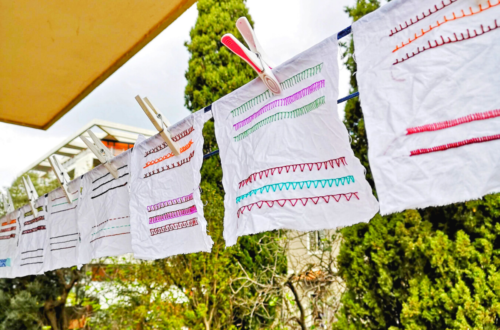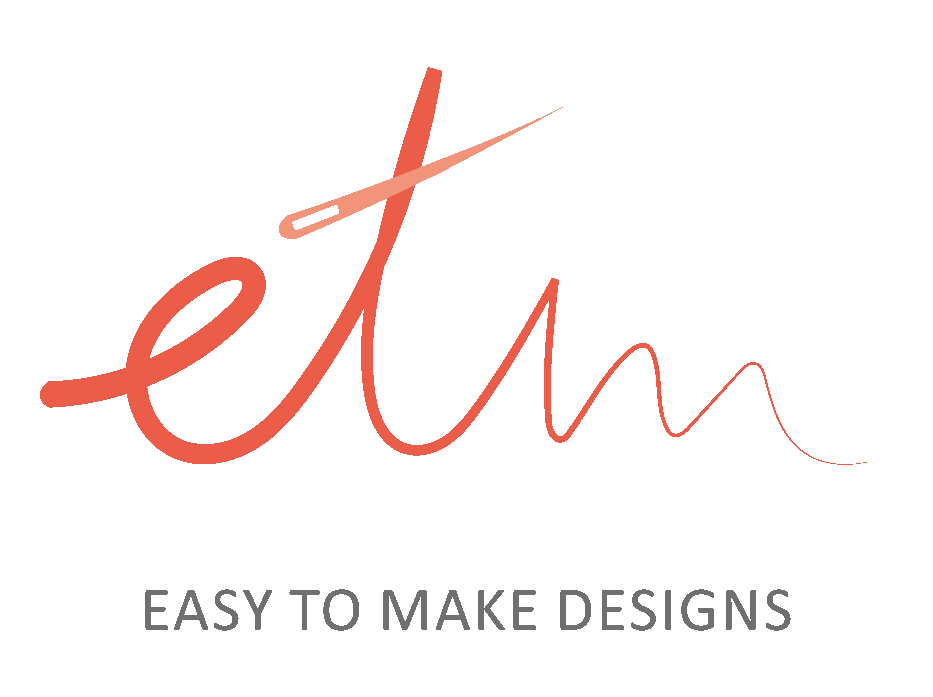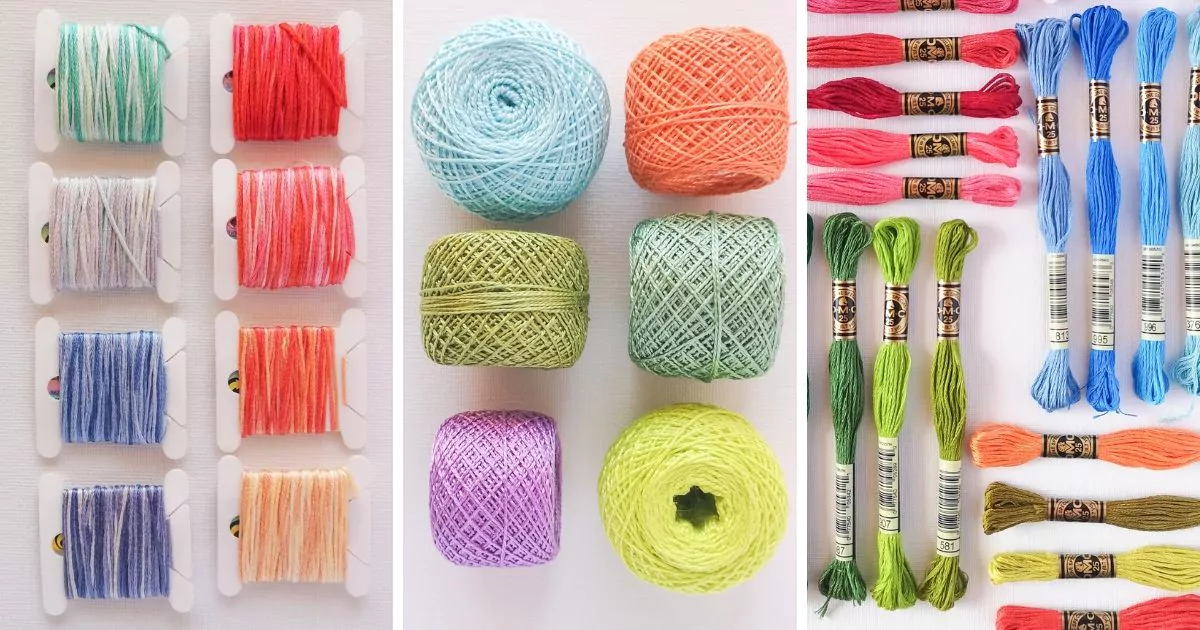
Types of hand embroidery thread
Cotton mouline, Pearl cotton, Rayon floss, Variegated threads and much more
In this article, I would like to write more in detail about different types of hand embroidery threads and where these threads can be used. There are many types of yarns that are created for hand embroidery purposes. Your choice will depend on the fabric you use, the style of the embroidery, and the effect you want to achieve. Let’s see in detail what types of thread there are available and how to select the best thread for your project.
Stranded Embroidery Cotton
Stranded Embroidery Cotton is also known as Embroidery floss or cotton mouline. It’s a classic go-to for any traditional hand embroidery project from cross-stitch to silk shading. Works best on cotton, linen, and all types of cotton-linen mixed materials. There is a wide choice of colors, and you can use from 1 to 6 threads, which allow you to vary your stitching results depending on the number of strands used. Best known producers of embroidery floss are DMC (454 solid colors and 18 variegated colors available) and Anchor (460 solid shades and 24 multicolor shades). Still, there are also some smaller brands like Retors du Nord by Sajou, Cosmo, Aurifil, and others that offer high-quality floss.
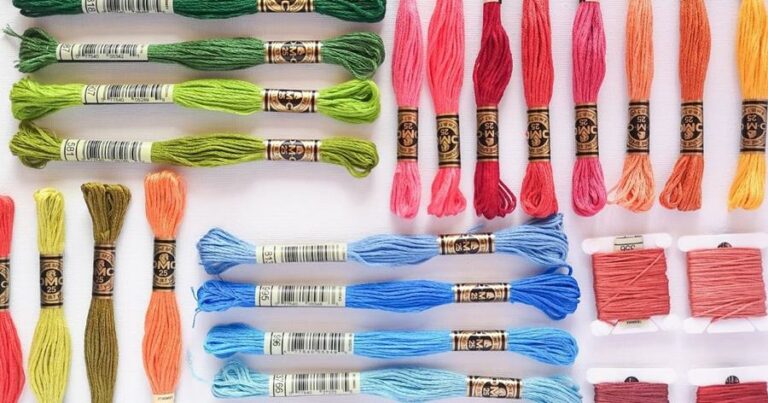
Pearl cotton
Pearl cotton is also called Perle cotton. Pearl cotton is a 2-ply twisted thread with a high sheen. Unlike stranded cotton, it is non-divisible (the strands cannot be separated). Pearl Cotton can be found in different thicknesses: 3, 5, 8, 12, and 16, with 3 being the heaviest and 16 the finest. Size 8 is equivalent to 3 strands of embroidery floss. Pearl cotton is used for cross-stitch, surface embroidery, and also, crochet. It is best to use it on natural fabrics like cotton or linen. The best-known producers of Pearl cotton are DMC and Anchor. They offer a wide range of colors and sizes.
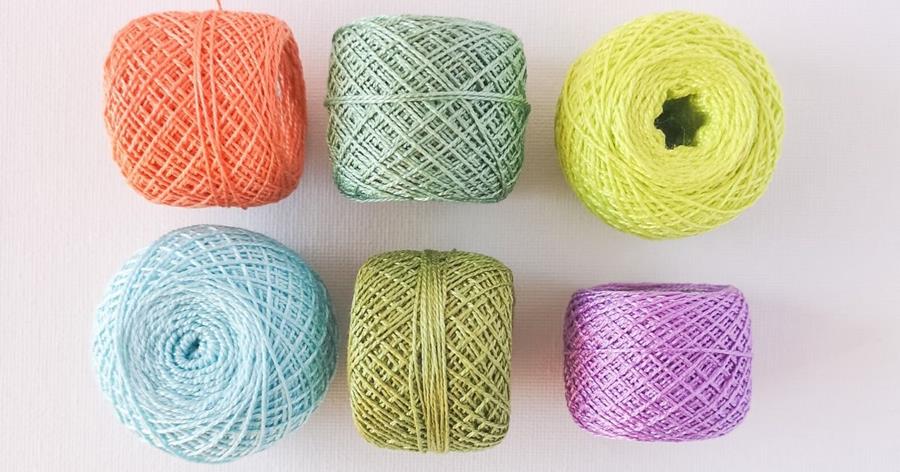
Rayon Floss
Rayon is a man-made, synthetic fiber, which gives the appearance of silk while being more economical. Rayon fibers are best known for their use in Brazilian embroidery, but they can be used in other techniques as well. You would probably want to use them for a specific area, rather than stitching the whole piece in rayon. It can add some charming shiny effects on your art piece or clothes. Best known producers of rayon are DMC (DMC Satin Rayon Floss), Anchor (Anchor Marlitt), EdMar (Cire, Lola).
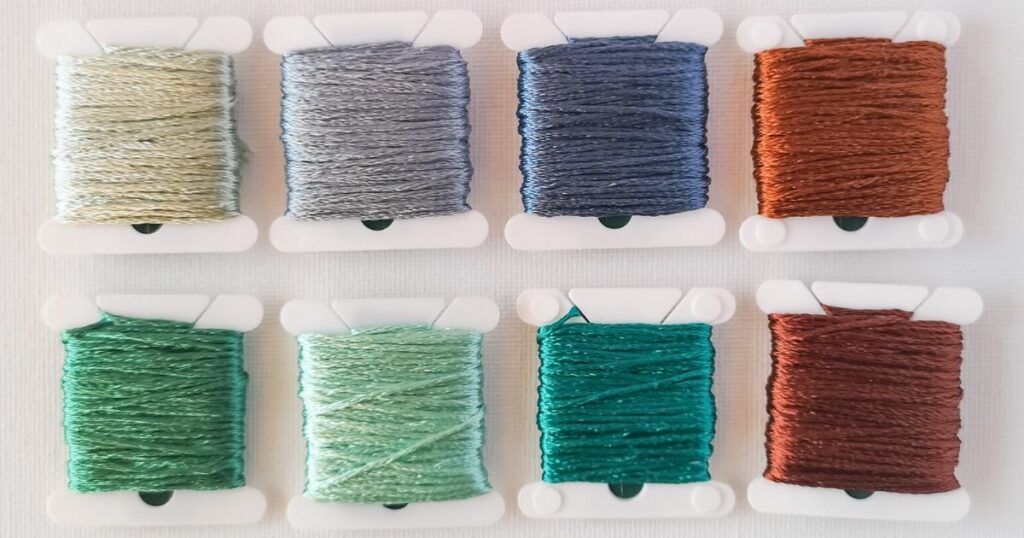
Metallic thread
There are several types of metallic embroidery thread:
- Regular Stranded Metallic Floss (like DMC’s Light Effects or Anchor Metallic)
- Woven Metallic Floss (like Kreinik Fine Braid or Au Ver a Soie braid) and
- Metallic Blending Filament, which is typically worked alongside other embroidery threads (like Anchor Lamé).
Also, recently DMC released a new metallic thread which is called DMC Diamant. I’m not sure which group it belongs to. When stitched up, Diamant is equal in thickness to about two strands of DMC floss, and, unlike most of the metallic threads, it’s much easier to work with. All metallic threads can be used for the lettering or adding some details to colored embroideries. Keep in mind that all metallic threads require some experience and a lot of patience as they tend to break and tangle while embroidering.

Crewel yarn
Crewel yarn is a 2-ply (2 strands twisted to make 1 thread) wool thread. Unlike standard cotton embroidery floss, you don’t separate this thread, and it’s much thinner than tapestry wool. As the name suggests, this thread is used for crewel embroidery (on linen and linen twill). Still, you can also use this thread to embroider on wool clothes and knitwear. Also, crewel yarn is used folded double to make cross-stitch on a 10 count canvas base. Best known Crewel threads are Fine d’Aubusson by Au Ver a Soie, Appleton wools, Bella Lusso, and Simply Wool by Gentle Art.
Tapestry Wool
Tapestry Wool is much thicker than crewel, almost like knitting wool. It is 4 ply (4 strands twisted to make 1 thread) and is used as a single strand to stitch on canvas base when doing canvas work or tapestry. It can also be used to embroider on thicker wool knitwear and other looser woven materials. Best known tapestry wool producers are DMC (Tapestry wool), Anchor (Tapisserie Wool), and Appleton Wools.
Silk Threads
There are two main types of silk threads – spun silk and filament silk. Spun silk is made from broken silk cocoons and leftovers, and spun into a yarn, similar to the way that cotton or wool are spun. Like cotton, a skein of spun silk consists of a thicker thread that can be separated into strands. You can stitch with spun silk in the same way that you stitch with cotton floss. It especially looks good in silk shading as the colors blend in very smoothly. Best known producers of spun silk are Au Ver a Soie ( Soie d’Alger), used by biggest high fashion brands and by many hand dyers, Madeira and Kreinik (Silk Mori).
Filament silk is not “spun” from fibers like spun silk, but reeled straight off the cocoon. Filament silks can be flat or twisted. Best known producers of filament silk are Au Ver a Soie, The Silk Mill, Trebizond, and Mulberry Silks.
The problems encountered when using silk threads in embroidery work are that they fade very quickly, and they may bleed. Despite these small flaws, silk is a lovely and pleasant thread to work with.
Ribbons
Many different types of ribbon can be used for hand embroidery. These ribbons can be silk, cotton, or synthetic and are available in varying widths, from a narrow 1/8 inch to 1/2 inch or larger. Ribbon embroidery can be used on its own or in combination with other surface embroidery styles to add some details.
Sashiko thread
Sashiko thread is a tightly twisted heavy-weight cotton thread that is used in traditional Japanese sashiko. Sashiko is a form of Japanese folk embroidery using the basic running stitch to create a patterned background. Traditional sashiko uses indigo dyed fabric and white sashiko thread. Still, you can find sashiko thread in many colors and even variegated ones. Sashiko thread is not made in strands like embroidery thread, it is made of fine threads twisted together to make a single thread (yarn). You use the entire strand when stitching with it. This thread is made with a rougher texture and has a flat rather than a shiny finish. If you want to achieve an authentic sashiko look, you should definitely search for sashiko threads and use them. Best known sashiko thread producers are Olympus (Kogin and Coron Sashiko Threads), Cosmo Lecien (Hidamari Sashiko thread), Yokota, and Maito.
Floche
Floche is a twisted thread made from the finest long fiber cotton, mercerized to create a beautiful finish. Floche is made up of five plies twisted together to make one non-divisible thread. Floche is different from stranded cotton as it is a 5-ply lightly twisted yarn that gives much better coverage than 2 plies stranded floss. This superior quality thread is especially suited for delicate embroidery. The best-known producer of Floche is DMC (DMC Floche comes in 94 colors).
Coton a broder
Coton a broder is a 100% cotton non-divisible thread, durable and color-fast especially suitable for delicate embroidery on table linen, furnishings, monogramming, whitework, and cutwork. In white, Coton a broder is available in a range of sizes, from size 16 (the largest) through size 35. Only one size of Coton a broder – size 25 – comes in colors. The best-known producer of Coton broder is DMC (DMC Coton broder comes in 182 colors).
Variegated embroidery threads
Variegated embroidery threads are embroidery threads that change color within the same thread. So it can be variegated cotton floss, variegated pearl cotton, or even variegated wool. Variegation can be a result of over-dyeing thread, space dyeing threads, and other methods applied. There are two main types of variegated color blends, tone on tone, and contrast. Tone-on-tone colors consist of multiple shades of a single color, such as dark green and medium green, that provide a gradient effect when stitched. Contrast colors include multiple colors that are dyed in a repeating pattern and stand out against the fabric. Variegated floss is a great way to add dimension to your project. Most embroidery thread producers have variegated thread lines.
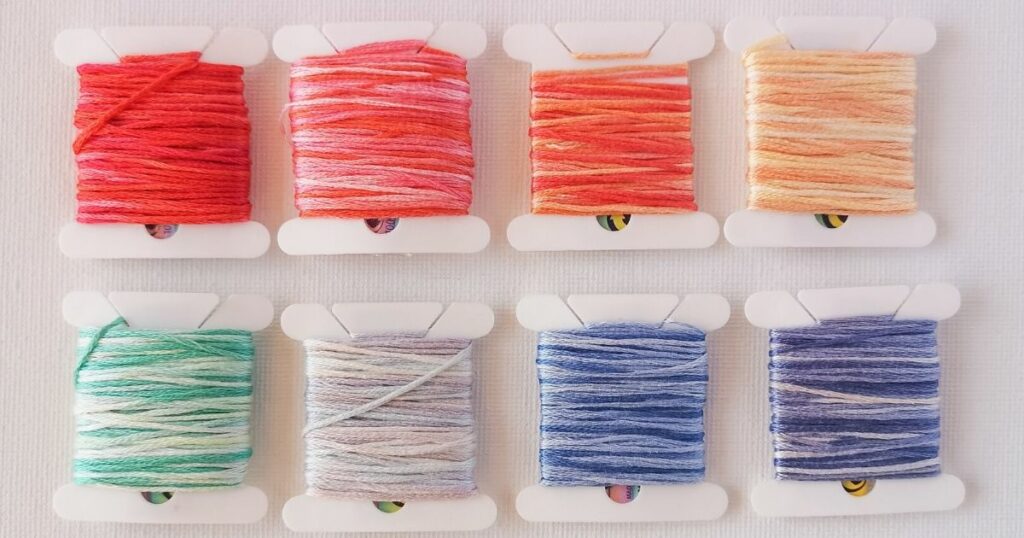
Other threads
In general, in hand embroidery, you can use any thread that can be threaded into the needle and passed through the fabric. Knitting yarns can be couched with sewing threads. The mix of all possible thread combinations and techniques can be used in one piece to create an original piece of fiber art.
Want to learn more?
In my previous blog post, “Embroidery threads. All you need to know about hand embroidery threads and floss” I’ve answered many common questions about hand embroidery threads and floss. You can read it here.
Also, you can find information about hand embroidery needles in the article “Everything you need to know about hand embroidery needles”



You May Also Like
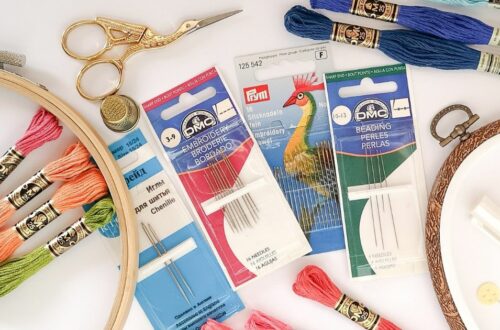
Everything you need to know about hand embroidery needles
28 October 2019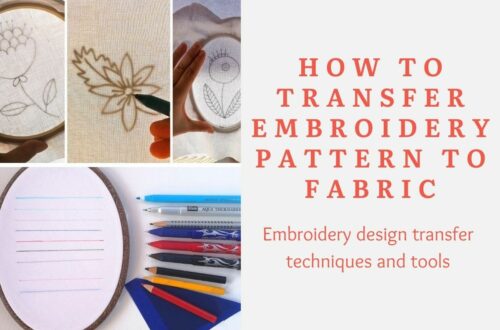
How to transfer embroidery pattern to fabric. Embroidery design transfer techniques and tools
14 September 2020